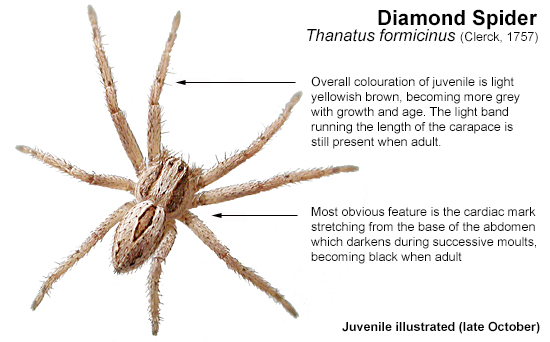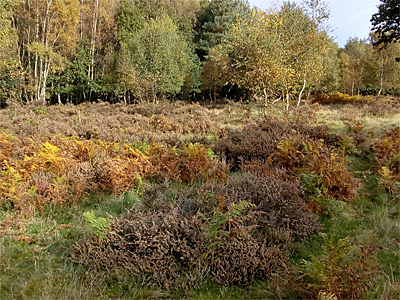

| Thanatus formicinus - Clumber Park's rarest spider |
| ...... |
| The discovery of this spider on heathland at Clumber Park in 2017, represents one of the county's most unexpected and surprising invertebrate records of recent years. Thought to have been extinct in the UK since 1969, the possibility of Thanatus formicinus (often referred to as the Diamond Spider by the UK's media) occurring again any time soon, had probably never entered the heads of most arachnologists. |
| ..... |
| Being of national significance, it was a find
which we obviously wanted to be able to report to local naturalists and
give publicity to via the
website. Unfortunately, and despite being informed of the record shortly
after discovery, we were asked not to publish the
record. At the time of the find, we were asked by one of the spider's original finders, for an identification of a spider in a photograph attached to their accompanying email. We identified it as Thanatus formicinus, which agreed with the finder's initial identification, but were quickly told in a follow-up email, that it would be preferred if we let the National Trust publicise the find in a press release. That would allow the National Trust to get deserved publicity and aid the spider's finders of any future survey work. We had no problem with their wishes, but did want to illustrate the spider on the website. Regular visitors will know that the primary aim of this website, has always been to generate greater awareness of Nottinghamshire's invertebrates and we were somewhat 'put out' by such a negative reaction. We've never liked secrecy. |
 |
| Why even ask us for an
identification of the spider at the time of the find, surely knowing we
would likely to want to illustrate it on the website? Even the site
was'nt divulged to us - just that it was in Nottinghamshire, on
heathland and on National Trust land, which immediately narrowed it down to Clumber Park. Our request for the
chance to photograph the spider for ourselves, was declined on
the basis that the spider was now a 'specimen' awaiting determination. In the end the whole episode left us feeling rather bitter about the whole thing and I later felt that I had to voice our opinion on the way the find had been handled from our point of view. Rather disappointingly (but perhaps not surprisingly) we were never invited to look for the spider ourselves during follow-up surveys in 2018 and 2019. Previous UK records and sites Sometimes known as the Diamond Spider, Thanatus formicinus (Clerck, 1747) was only previously known from a handful of sites in southern counties and was believed to have become extinct in the UK more than 50 years ago. According to the Spider Recording Scheme's website, it was recorded in 1894 near Brockenhurst in the New Forest and from two sites in Ashdown Forest, East Sussex in the 20th century. |
| ..... |
 |
It was apparently well-established when found in Ashdown Forest, but
searches in recent years have not rediscovered the spider and the
habitats are thought to have become less suitable. It is a widespread species in western and central
parts of Europe.
Nottinghamshire records of Thanatus formicinus
Thanatus formicinus (Clerck, 1757) is a distinctive spider and one that despite being small, is still relatively easy to identify in the field. Nottinghamshire's first record came from Clumber Park on September 7th 2017 (Stockton, L. and Harris, T.) during voluntary survey work on an area of heathland situated on the south side of Clumber Lake. Targetted surveys for the spider led by the British Arachnological Society, have produced further records in the past two years..
Despite its undoubted rarity, Thanatus formicinus suddenly turning up in VC56 would indicate that the spider has obviously remained undetected here for many years. Found on what is a relatively small area of pretty uninspiring heathland (by Sherwood Forest's standards) it would be logical to presume there are other small pockets of habitat across the Sherwood Forest area, where small populations of the spider could also occur. |
|
| .... | ||
|
Just about anywhere would be worth checking, but the less grazed areas of Budby South Forest would have to be one of the most likely sites, as would the eastern side of the Gleadthorpe Open within the Sherwood Forest CP. Rainworth Heath SSSI might be an even more likely site, but it would probably take a number of visits to rule out the spider not being present at any of these sites.
In search of Thanatus formicinus
Although having been aware of the general location of the spider for a year or so, I decided to finally go and look for it in October 2019 after getting more precise information on the spider's location from two local naturalists who had both already seen T. formicinus. On reaching the location, I was somewhat disappointed at just how unremarkable the habitat was. Best numbers of the spider had come from the small area of grazed heathland shown in the photograph above left. Its quite typical of the heathland remaining throughout the Sherwood Forest area and my initial reaction was "if its here, it just has to be on Budby".
Thanatus formicinus is best looked for by lifting up stands of heather in habitat similar to that shown, especially where the heather is growing into grass and easily lifted up. The method I employed was to lift up suitable heather, give it a shake, then wait for any spiders to appear. I only used a pot to catch those spiders I suspected may be T. formicinus, but did record a single example of Thanatus striatus. (C.L.Koch, 1845). This is another uncommon spider, with Nottinghamshire records from Rainworth Heath SSSI and a number of sites in the Sherwood Forest area. One of the commonest spiders present under the heather proved to be Zora spinimana (Sundevall, 1833). It took several attempts, but after no more than ten minutes I had found the first of two similar sized specimens, both of which were immature. There were of course, a whole range of (mostly immature) species to go through and for some reason, immature T. formicinus turned out to be smaller than I had expected and is easily missed. |
||
| Spiders | ||
| Homepage | ||